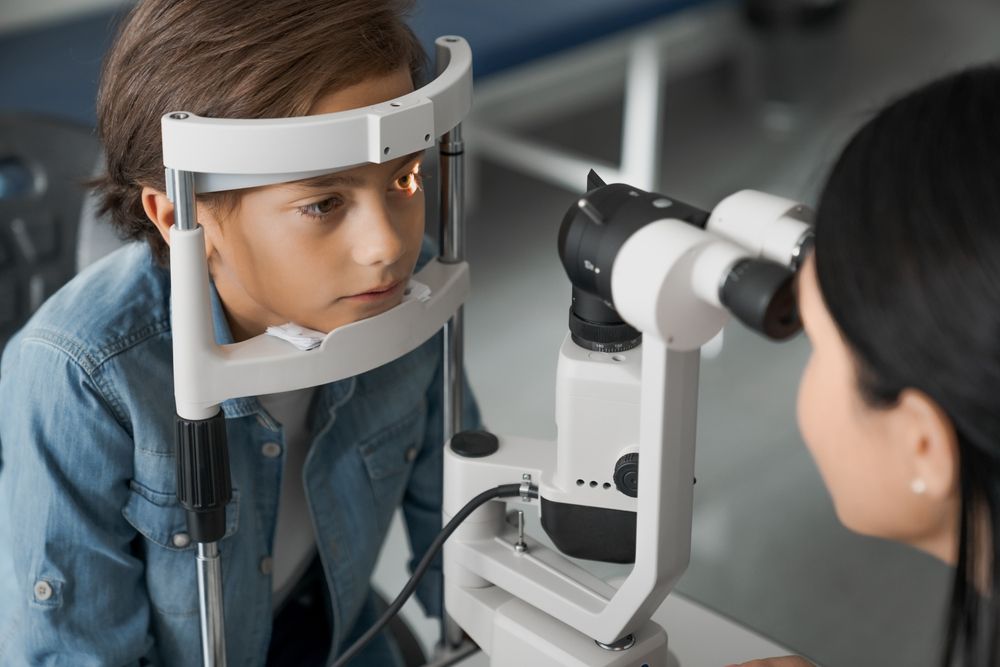Strabismus, commonly known as crossed eyes, is a condition where the eyes do not align properly, pointing in different directions. This misalignment can occur occasionally or persistently and is most commonly diagnosed during childhood. One eye may focus on an object while the other eye may turn inward, outward, upward, or downward.
At Colorado Eye Clinic in Greenwood Village, Dr. Abed Namavari specializes in diagnosing and treating strabismus, providing customized care for children in Centennial and Southglenn as well.
Causes of Strabismus in Children
Strabismus occurs when there is a disruption in the coordination between the muscles controlling the eyes. Several factors can contribute to this condition:
- Muscle Imbalance: Weakness or overactivity in one or more eye muscles can lead to misalignment.
- Refractive Errors: Significant nearsightedness, farsightedness, or astigmatism may cause the eyes to strain and misalign.
- Family History: A genetic predisposition can increase the likelihood of a child developing strabismus.
- Neurological Conditions: Issues affecting the brain’s control of eye movements, such as cerebral palsy, can result in strabismus.
- Other Health Conditions: Premature birth, low birth weight, or Down syndrome may elevate the risk of strabismus.
Signs of Strabismus Parents Should Notice
Early detection of strabismus is crucial for effective treatment. Parents should look out for the following signs:
- Eyes that appear misaligned, especially in photos
- Squinting or tilting the head to focus
- Difficulty focusing on objects
- Complaints of double vision or blurry vision
- A lack of depth perception
If you notice these signs in your child, a comprehensive eye examination is recommended.
Diagnosing Strabismus
At Colorado Eye Clinic, Dr. Namavari uses advanced tools and techniques to accurately diagnose strabismus. The evaluation includes:
- Visual Acuity Tests: Measuring the clarity of vision in each eye.
- Alignment Tests: Assessing how the eyes work together to focus on a target.
- Refraction Tests: Identifying underlying refractive errors contributing to strabismus.
- Eye Health Examination: Checking for structural issues or neurological causes of misalignment.
Types of Strabismus
Understanding the specific type of strabismus is essential for tailoring treatment. The condition is categorized based on the direction of misalignment:
- Esotropia: One eye turns inward toward the nose.
- Exotropia: One eye drifts outward.
- Hypertropia: One eye shifts upward.
- Hypotropia: One eye moves downward.
Strabismus can also be classified by its frequency, such as intermittent (occurring sporadically) or constant (always present).
Treatment Options for Strabismus
Strabismus treatment aims to align the eyes, restore binocular vision, and improve depth perception. Dr. Namavari offers several evidence-based treatment options:
Non-Surgical Treatments:
- Corrective Lenses: Glasses or contact lenses can address refractive errors, reducing eye strain and improving alignment.
- Vision Therapy: Eye exercises and activities designed to strengthen coordination and improve muscle control.
- Patching: Covering the stronger eye with a patch to encourage use of the weaker eye, which can help correct alignment over time.
Surgical Treatments:
For cases where non-surgical methods are insufficient, surgery may be necessary to adjust the muscles controlling eye movement. Strabismus surgery is a precise procedure that repositions the muscles to improve alignment.
How to Support Your Child Through Treatment
Successful management of strabismus requires a collaborative effort between parents, children, and healthcare providers. Consider these practical tips:
- Encourage Compliance: Ensure your child wears their glasses or patch as prescribed.
- Incorporate Exercises: Make vision therapy activities fun and engaging to promote participation.
- Attend Follow-Ups: Regular visits to Colorado Eye Clinic in Greenwood Village are essential for monitoring progress.
- Communicate: Reassure your child that treatment will improve their vision and quality of life.
Preventing Complications
Without treatment, strabismus can lead to long-term complications such as amblyopia (lazy eye) or loss of depth perception. Early intervention is critical in preventing these issues. Regular eye exams are recommended for all children, especially those with a family history of vision problems.
The Importance of Early Diagnosis
Early diagnosis and treatment of strabismus can significantly improve outcomes. Children’s brains are highly adaptable, and addressing misalignment early allows the brain and eyes to work together effectively. At Colorado Eye Clinic, Dr. Namavari is committed to providing timely, comprehensive care to children in Greenwood Village, Centennial, and Southglenn.
Choosing Colorado Eye Clinic for Strabismus Care
Located in Greenwood Village, Colorado Eye Clinic is a trusted provider of pediatric eye care. Dr. Abed Namavari combines advanced diagnostic tools with personalized treatment plans to ensure the best outcomes for children with strabismus. Serving families in Centennial and Southglenn, our clinic is dedicated to helping every child achieve clear, aligned vision.
For expert care, contact Colorado Eye Clinic today to schedule a consultation. Strabismus is treatable, and early intervention can set your child on the path to optimal eye health.
Sources:
- Holmes, J. M., & Clarke, M. P. (2006). Amblyopia and Strabismus. The Lancet.
- Wright, K. W., & Spiegel, P. H. (2006). Pediatric Ophthalmology and Strabismus. Springer.
- Birch, E. E. (2013). Visual Development in Early Childhood. Current Ophthalmology Reports.

